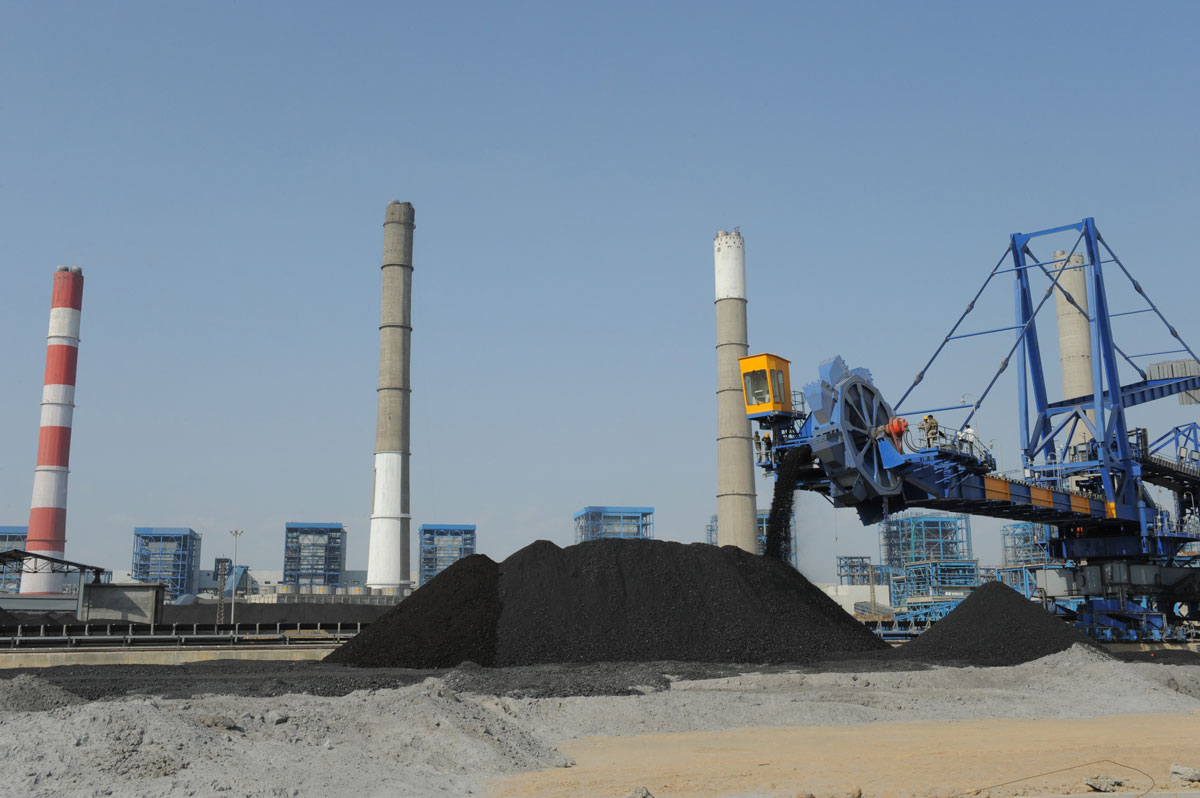DEVELOPMENT IN INDIA
File photo of workers using heavy machinery to sift through coal at the Adani Power company thermal power plant at Mundra some 400 kms from Ahmedabad. This was India’s first supercritical 660 MW unit. (Sam Panthaky | AFP | Getty Images)
Indian Prime Minister Narendra Modi has often evoked Jawaharlal Nehru in his speeches, though in the recent past he has been quoting Dr. B.R. Ambedkar extensively, perhaps keeping in mind the upcoming elections in Uttar Pradesh where the dalits are electorally very significant, writes Siddharth Srivastava.
Nehru economic vision, as is well known, sought to back large government projects, whether for building dams, setting up steel factories or oil refineries. These gargantuan ventures involving big investments were supposed to form the bedrock, the commanding heights of the Indian economy. The economic climate of the country has obviously changed since the time of Nehru with economic liberalization initiated in the 90s. The private sector today, for instance, has the capability to take on large projects given returns pegged to a fast-growing Indian market.
Modi’s economic vision is seen to be more pragmatic rather than constrained by ideology. The focus is on effective solutions to promote private industry, employment, Make in India, unleashing growth via fair competition. At the same time there are attempts to protect the poor, enabling them via skill development and targeted subsidies. There is a conscious effort to make the functioning of the government more efficient, reduce corruption and leakages by deploying technology.
There is, however, one critical sector where Modi’s ideas seem to merge with Nehru. It is the urgent need to back big ticket projects to rid India of its perpetual power deficit. Recently Modi initiated construction of an 8,000 MW capacity power plant, which will be India’s biggest, in the eastern coal rich state of Jharkhand. The thermal project will be built by a joint venture company of state-owned National Thermal Power Corporation (NTPC), India’s largest generator and Jharkhand government. Bulk of the power will be consumed within Jharkhand, while the rest will be sold to other states. About 1,200 acres of land has already been transferred to the JV company while another 600 acres will be transferred in future. The land is owned by the state government which is a crucial factor as fresh acquisition of real estate is not an easy process in India.
Indeed, apart from renewable energy, the Indian government has been focusing on large power projects to enable the country to meet rapidly rising demand for electricity. In his 2015 budget speech, finance Minister Arun Jaitley said the government proposes to set up five new UMPPs in the plug-and-play mode this fiscal, each involving an investment of Rs. 300 billion.
New Delhi is likely to approve standard bid document for Ultra Mega Power Projects (UMPPs) based on domestic coal by May. In a comment made in the third week of April, power and coal minister Piyush Goyal said: “We have taken out the (standard bid) documents for Cabinet approval. They may come up this week or the next week. Simultaneously, we are in dialog with several states where UMPPs have to be bid out.” After Cabinet approval, New Delhi is expected to float tenders for the five UMPPs, each of 4,000 MW capacity at Banka in Bihar, Tilaiya and Deoghar in Jharkhand, Bedabahal in Odisha and Surguja in Chhattisgarh.
India’s attempts to build UMPPs in thermal power has not yielded targeted results. So far only two UMPP’s, Reliance Power’s Sasan project in Madhya Pradesh and Tata Power’s Mundra plant in Gujarat are operational. The numbers will hopefully go up if the Modi government has its way.
No doubt, sustained endeavor by New Delhi to ramp up the power sector seems to be progressing well. Efforts, for example, to improve performance of state-owned Coal India Limited (CIL), India’s monopoly coal producer, to feed the power plants is yielding results.
Due to rising production of the dry fuel, India plans to stop thermal coal imports in 2-3 years resulting in annual savings of Rs. 400 billion. Record coal production by CIL helped India reduce its coal import bill by more than Rs. 280 billion in the last fiscal. In fact, there is worry CIL is producing more than it can sell. Local media reports say India may have overestimated electricity demand over the next five years, which could lead to low capacity utilization of plants. An exercise by the power ministry reportedly suggests demand could be 15% less than projected.
Nehru is a colossal figure who had a big role in shaping India’s history. Modi is still in the process of writing his legacy. There is still a question mark whether he will be able to carve a niche for himself away from the overbearing shadow of the right wing RSS that has always had a big say in the way BJP governments have functioned, whether at the state or central levels.
Indeed, analysts, historians, intellectuals will discuss and debate for years about the impact of Modi’s rule on the country. In the power sector, however, there is likely to be some agreement and common ground that Modi’s ideas bordered on the Nehruvian in spirit.


